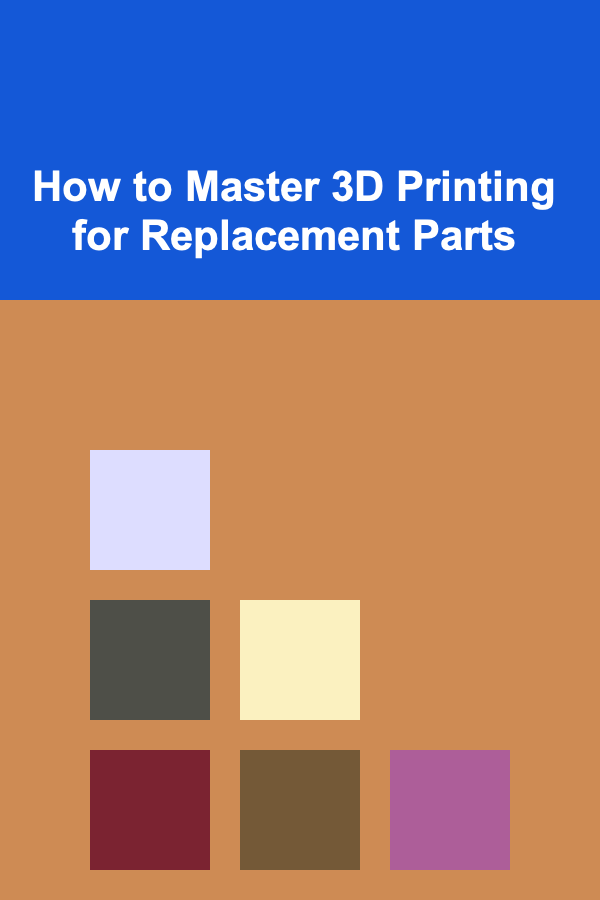
How to Master 3D Printing for Replacement Parts
ebook include PDF & Audio bundle (Micro Guide)
$12.99$6.99
Limited Time Offer! Order within the next:

3D printing, also known as additive manufacturing, has emerged as a revolutionary technology in various fields, from medical applications to industrial manufacturing. One of the most practical and transformative uses of 3D printing lies in the creation of replacement parts. Whether you're in the automotive industry, aerospace, or even home repair, 3D printing can provide an efficient, cost-effective, and often quicker solution to sourcing replacement parts.
In this article, we will explore the fundamental principles of 3D printing, the benefits of using it for replacement parts, the challenges to consider, and how to master 3D printing in this context. By the end, you will understand how to implement 3D printing in your own operations or repairs, whether on a small scale for personal use or a larger scale for industrial applications.
The Basics of 3D Printing
Before delving into the specifics of 3D printing for replacement parts, it's essential to understand the fundamentals of the technology. At its core, 3D printing is a process where material is deposited layer by layer to build up a three-dimensional object from a digital model.
Common 3D Printing Methods
Several types of 3D printing techniques are used, depending on the material, object complexity, and application. The most common methods include:
- Fused Deposition Modeling (FDM) -- This is the most widely used form of 3D printing for home use and prototyping. In FDM, plastic filament is heated and extruded layer by layer to form the object. It is inexpensive and works well for simple, non-load-bearing replacement parts.
- Stereolithography (SLA) -- SLA uses a laser to cure liquid resin into solid material, creating extremely detailed parts with smooth finishes. It's commonly used in dental and jewelry applications but is also useful for replacement parts requiring high precision.
- Selective Laser Sintering (SLS) -- SLS uses a laser to fuse powder particles together to form a solid object. It allows the creation of complex geometries and is used for industrial-grade replacement parts, especially in aerospace and automotive industries.
- Direct Metal Laser Sintering (DMLS) -- This method is similar to SLS but focuses on metal powders, offering the ability to create durable, high-strength parts suitable for industries like aerospace and automotive.
Materials Used in 3D Printing
The choice of material is crucial for the success of 3D printed replacement parts. Depending on the method and intended use of the part, a range of materials can be employed:
- Plastics: PLA, ABS, PETG, and Nylon are common for non-structural parts, as well as for prototypes and consumer-level replacements.
- Metals: Stainless steel, titanium, aluminum, and other alloys are used in more robust, industrial applications where strength and durability are paramount.
- Composites: Some 3D printing methods use composite filaments that combine plastic with other materials like carbon fiber or glass fiber to increase strength and reduce weight.
Digital Modeling
Before any 3D printing job can begin, the part must be modeled in 3D. This can be done using various CAD (Computer-Aided Design) software, which allows for the creation of precise 3D representations of the part to be printed. For replacement parts, it is essential to have accurate measurements, especially when replacing intricate components that need to fit precisely.
Why 3D Printing is Ideal for Replacement Parts
There are several reasons why 3D printing is particularly suited for manufacturing replacement parts.
1. Cost-Effectiveness
One of the most significant advantages of 3D printing is that it is often far more affordable than traditional manufacturing processes. Traditional methods of producing replacement parts, such as injection molding or casting, require expensive molds and tooling, which makes small-batch production expensive.
In contrast, 3D printing eliminates the need for molds and tooling. You can print a single replacement part on-demand, reducing the upfront costs associated with traditional manufacturing. Additionally, materials can be used more efficiently, reducing waste.
2. Speed and On-Demand Production
When a machine or component breaks down, waiting for a replacement part to be manufactured and shipped can lead to significant downtime. 3D printing allows for on-demand production, meaning that once you have the necessary digital model, a replacement part can be printed in a matter of hours or days, reducing downtime significantly.
This is especially important in industries like aerospace or automotive, where downtime costs are extremely high. Instead of waiting weeks for a part from the manufacturer, companies can print the part and have it ready to go in a much shorter time frame.
3. Customization
In many industries, replacement parts need to be tailored to specific needs. 3D printing offers unprecedented customization, allowing manufacturers to print parts with complex geometries and specific material properties. Whether you're creating a part for an old or obsolete machine or need a modification for a specific use case, 3D printing allows you to design and create exactly what you need.
For instance, in the medical industry, custom prosthetics or implants can be made using 3D printing, offering a perfect fit for the patient's needs.
4. Complex Geometries
Traditional manufacturing methods often struggle to produce parts with intricate designs or internal structures, especially when they are needed for complex machinery or devices. 3D printing, however, allows the creation of parts with intricate internal structures or geometries that would be difficult or impossible to produce using conventional methods.
This capability is particularly valuable for replacement parts that must fit into tight spaces or require complex functionality. For instance, a 3D printed replacement part for a pump or valve may include internal channels or cavities that would be hard to manufacture using traditional methods.
5. Reduction in Inventory and Supply Chain Costs
With 3D printing, businesses can produce parts on-demand, reducing the need to keep large inventories of replacement parts. This can lead to significant cost savings, especially for companies that produce equipment with a wide range of possible parts. By maintaining a digital catalog of parts, companies can print a replacement when needed rather than store large quantities of physical stock.
This also reduces the burden on the supply chain, as parts can be printed at the point of use, eliminating transportation costs and delays.
Challenges in 3D Printing Replacement Parts
While 3D printing for replacement parts offers numerous benefits, it also comes with its own set of challenges that need to be addressed.
1. Material Strength and Durability
While 3D printing can produce high-quality replacement parts, not all materials are suited for all applications. Some 3D printed materials, particularly plastics, may not offer the same level of strength or durability as traditional materials. For parts that are subject to heavy loads, high temperatures, or harsh environments, it's important to choose the right materials or ensure that they are reinforced, such as with carbon fiber or metal composites.
2. Surface Finish and Accuracy
Although 3D printing can produce highly accurate parts, the surface finish of printed parts may not always meet the standards required for certain applications. Depending on the method and material used, printed parts can sometimes exhibit visible layer lines, rough surfaces, or other imperfections. Post-processing steps such as sanding, polishing, or coating may be necessary to improve the finish of the part.
3. Design Complexity
While 3D printing allows for complex geometries, creating designs that fully take advantage of these capabilities requires skill and expertise. Many designers are still accustomed to traditional manufacturing methods and may not be fully aware of the potential of 3D printing. Learning to design for 3D printing involves understanding the limitations of the technology, such as print orientation, material properties, and support structures.
4. Quality Control
Ensuring the quality and consistency of 3D printed parts can be challenging. Unlike traditional manufacturing methods that rely on strict quality control standards, 3D printing is highly dependent on the printer, the material, and the design file. In industrial settings, where part quality and reliability are critical, it is essential to implement robust quality control systems to ensure that every part meets the required standards.
5. Post-Processing Requirements
Many 3D printed parts require post-processing to ensure they are ready for use. Depending on the material and printing method, this can include removing support structures, curing the material, or finishing the surface. These post-processing steps can add time and cost to the overall production process.
Mastering 3D Printing for Replacement Parts
1. Invest in High-Quality Equipment
To produce reliable and durable replacement parts, it is essential to invest in high-quality 3D printing equipment. For industrial applications, this may mean purchasing professional-grade printers that can handle higher volumes and offer better material compatibility. Desktop printers may suffice for personal use or prototyping but may lack the precision and material options needed for more demanding parts.
2. Learn About Design for Additive Manufacturing (DFAM)
Designing parts for 3D printing requires a different mindset than designing for traditional manufacturing methods. DFAM principles emphasize the design features that take advantage of 3D printing capabilities, such as lightweight structures, lattice frameworks, and optimizing the orientation of parts for printing.
Understanding these principles can help designers create more efficient, cost-effective, and functional replacement parts.
3. Choose the Right Materials
Selecting the correct material is critical when producing replacement parts. While plastics like PLA and ABS are suitable for many non-structural parts, metals or composite materials may be necessary for parts that require additional strength or heat resistance. Understanding material properties, such as tensile strength, heat deflection, and fatigue resistance, will help in choosing the right material for the job.
4. Develop a Post-Processing Strategy
Post-processing is an essential step in ensuring that your 3D printed parts meet the required specifications. Depending on the material, post-processing can involve sanding, polishing, or painting parts to improve their appearance and performance. In some cases, heat treatments or additional coatings may be necessary to increase the strength or durability of the part.
5. Quality Control and Testing
Before using a 3D printed part in a critical application, it's important to test it for strength, functionality, and fit. Depending on the use case, you may need to perform physical tests, such as stress testing, or conduct inspections using techniques like x-ray or ultrasound to ensure the part is structurally sound.
Additionally, maintaining a digital record of the 3D printing process, including material batches, print settings, and design files, can help ensure traceability and consistency in the production of replacement parts.
Conclusion
Mastering 3D printing for replacement parts is not just about having access to a 3D printer and materials. It involves understanding the technology, materials, and design principles that can help produce functional, durable, and cost-effective parts. Whether you're creating parts for home repair, small businesses, or industrial operations, 3D printing offers enormous potential to reduce costs, increase efficiency, and provide innovative solutions for sourcing replacement parts.
By addressing the challenges, such as material limitations, design complexities, and post-processing requirements, you can harness the full power of 3D printing and make it a central part of your replacement parts strategy.

How to Maintain Your Instruments in an Organized Space
Read More
How to Organize Your Wine Accessories in a Drawer
Read More
How to Stage Your Home Without Overwhelming Potential Buyers
Read More
How to Walk Your Way to Weight Loss
Read More
How to Explore Paris Like a Local
Read More
Exploring the Myths of the Andes Mountains: A Journey Through Culture, Cosmology, and History
Read MoreOther Products

How to Maintain Your Instruments in an Organized Space
Read More
How to Organize Your Wine Accessories in a Drawer
Read More
How to Stage Your Home Without Overwhelming Potential Buyers
Read More
How to Walk Your Way to Weight Loss
Read More
How to Explore Paris Like a Local
Read More